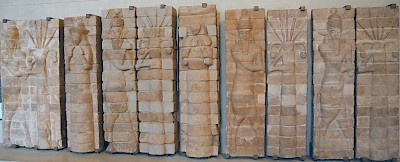Susa, Temple of the Šutrukids
Q30119101Susa (Elamitic, Babylonian: Šušim; Greek τὰ Σοῦσα): capital of Elam, favorite residence of the Persian king Darius I the Great.

The builder of the Dynastic Temple of the Šutrukids, Šilhak-Inšušinak, was king of Elam from c.1150 to c.1120 BCE, when this kingdom had reached the height of its power. Its armies had even been able to capture mighty Babylon and the statue of the Babylonian supreme god Marduk had, together with such objects as the Codex of Hammurabi, been transported to Susa.
The king of Elam decided two build two temples for the city's own god Inšušinak. One of them, called "the high temple", was on the Acropolis; the other one, "the outer sanctuary", was probably in the area that was later occupied by Darius' Apadana. (The exact location is not known, because the bricks of the façade have been used in later buildings (e.g., in an aqueduct) and were found on several locations.) This second temple had a special connection to the royal house and is therefore called the Dynastic Temple.
The façade, made of bricks, has been reconstructed in the Louvre. Three types of representation can be found: a bull-man, a palm tree, and a lama deity. The bull-man and the lama are common figures, often found near the gates of a palace; they were believed to ward off evil.
An inscription informs the reader that everything had been prepared by king Kudur-Nahhunte (c.1155-c.1150) and finished by his brother and successor Šilhak-Inšušinak.
 Susa, Temple of the Šutrukids, Relief |
 Susa, Temple of the Šutrukids, Relief: the bull-man |
 Susa, Temple of the Šutrukids, Goddess |
 Susa, Temple of the Šutrukids, Inscription |